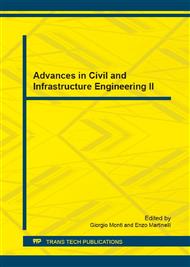[1]
L. J. Gibson, M. F. Ashby, Cellular Solids: structures and properties, Second Edition. Cambridge: Cambridge University Press, (1997).
Google Scholar
[2]
P. S. Liu, Introduction of porous materials, Beijing: Tsinghua University Press, (2004).
Google Scholar
[3]
S. W. Guan, Honeycomb structural material, Solar, 1(1999)25-26.
Google Scholar
[4]
Y. J. CHEN, X. Q. ZUO, Q. N. SHI, etc, Development and application of honeycomb metal, Mater. Rev. 17, No. 12(2003)32- 35.
Google Scholar
[5]
J. Zhang, M. F. Ashby, The out-of-plane properties of honeycombs, Int. J. Mech. Sci. 34, No. 6(1992)475-489.
Google Scholar
[6]
J. L. Grenestedt, Effective elastic behavior of some models for perfect cellular solids, Int. J. Solids Struct. 36(1999)1471-501.
DOI: 10.1016/s0020-7683(98)00048-1
Google Scholar
[7]
J. Hohe, C. Beschorner, W. Becher, Effective elastic properties of hexagonal and quadrilateral grid structures, Compos. Struct. 46(1999)73-89.
DOI: 10.1016/s0263-8223(99)00048-3
Google Scholar
[8]
A. J. Wanc, D. L. McDowell, In-Plane stiffness and yield strength of periodic metal honeycombs, J. Eng. Mater. Technol. 126(2004)137- 138.
Google Scholar
[9]
W. H. Zhang, G. M. Dai, F. W. Wang, et al, Using strain energy-based prediction of effective elastic properties in topology optimization of material microstructures, Acta Mech. Sin. 23, No. 1(2007)77-89.
DOI: 10.1007/s10409-006-0045-2
Google Scholar
[10]
X. Guo, L. J. Gibson, Behavior of intact and damaged honeycombs: A finite-element study, Int. J. Mech. Sci. 41, No. 11(999)85-105.
Google Scholar
[11]
C. Jaeung, M. W. Anthony, Compressive response of circular cell polycarbonate honeycomb under inplane static and dynamic loads, AIAA-2001-1187(2001)1-12.
DOI: 10.2514/6.2001-1187
Google Scholar
[12]
D. P. Scott, K. Stelios, In-plane crushing of a polycarbonate honeycomb, Int. J. Solids Struct. 35, No. 3(1998)239-267.
Google Scholar
[13]
B. Wilfnied, Closed-form analysis of the thickness effect of regular honeycomb core material, Compos. Struct. 48(2000)67-70.
DOI: 10.1016/s0263-8223(99)00074-4
Google Scholar
[14]
T. Kanyatip, A. Tatsuhiko, M. Toshiji, Symmetric and asymmetric deformation transition in the regularly cell-structured materials. Part I experimental study, Int. J. Solids Struct. 42, No. 8(2005)2199-2210.
DOI: 10.1016/j.ijsolstr.2004.09.028
Google Scholar
[15]
W. E. Baker, T. C. Togani, J. C. Weydert, Static and dynamic properties of high-density metal honeycombs, Int. J. Impact Eng. 21, No. 3(1998)149-163.
DOI: 10.1016/s0734-743x(97)00040-7
Google Scholar
[16]
Q. Zhou, R. Mayer, Characterization of aluminum honeycomb material failure in large deformation compression, shear, and tearing, J. Eng. Mater. Technology Transactions of the ASME, 124(2002)412-420.
DOI: 10.1115/1.1491575
Google Scholar
[17]
E. W. Andrews, G. Gioux, P. Onck, et al, Size effects in ductile cellular solids. Part II: Experimental results, Int. J. Mech. Sci. 43(2001)701-713.
DOI: 10.1016/s0020-7403(00)00043-6
Google Scholar


